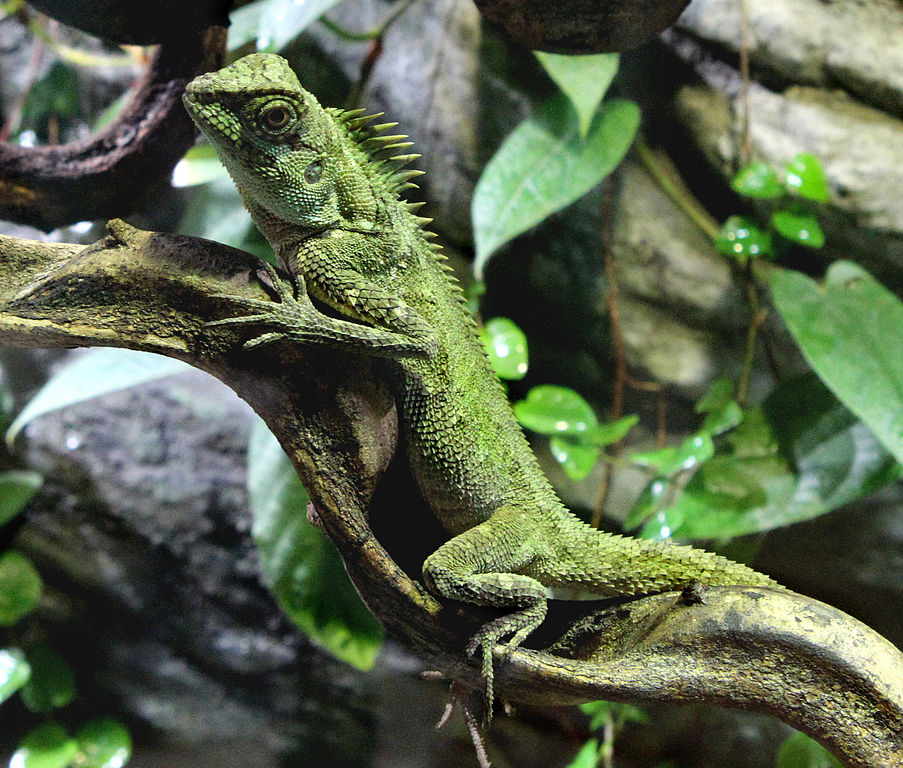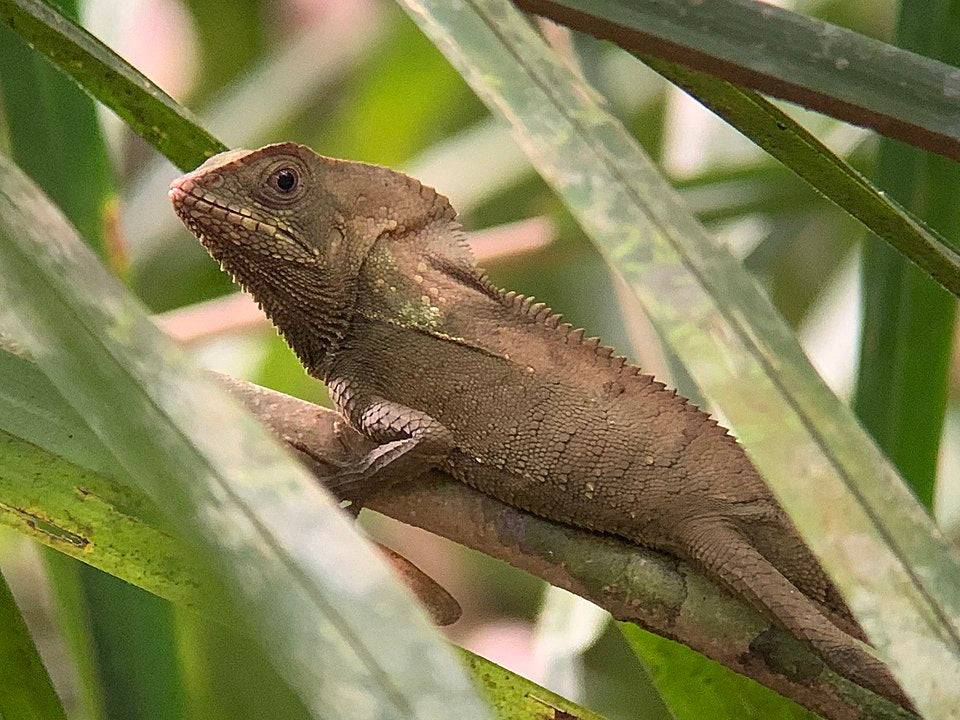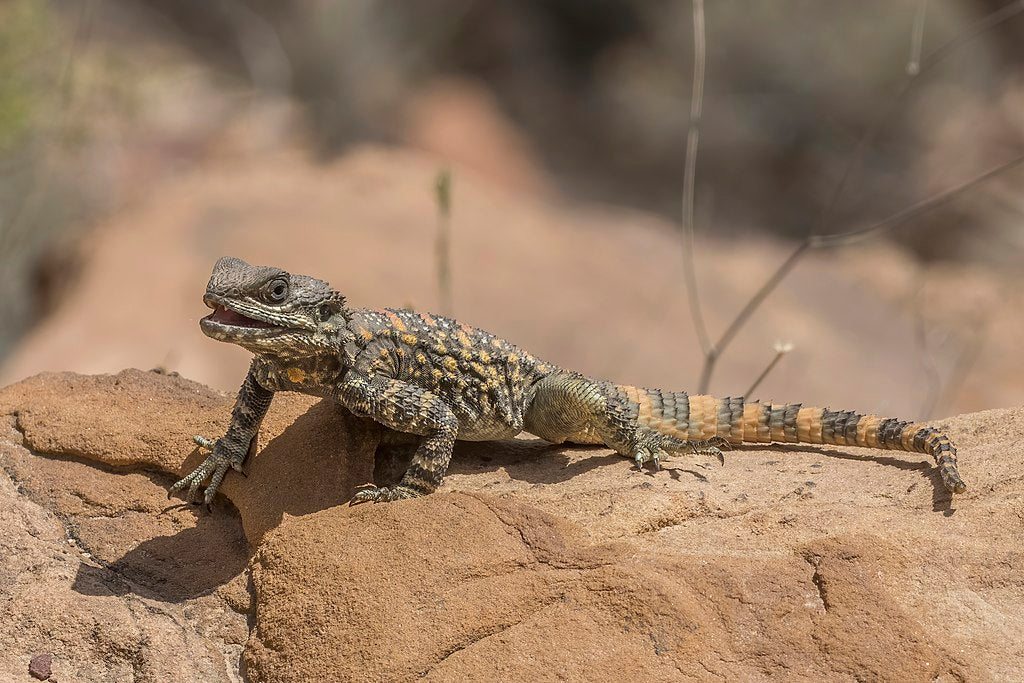Mountain horned dragons (Acanthosaura capra) are moderate-sized, diurnal, arboreal lizards native to southeast Asia, specifically Cambodia and Vietnam. They prefer tropical forest for habitat and are also known as the “green pricklenape.”
Mountain horned dragons are capable of growing up to 12” long, with most of their length being tail. They can be best identified by the elongated spines at the back of their neck, prominent brow ridges, beardlike throat pouch, large eyes, rough triangular scales, and shorter spines along the anterior portion of the back. Coloring and pattern are variable and may shift with the lizard’s mood. They typically have a base color of olive or brown, but green or almost black is possible. Markings may be golden yellow or white. They may have a spotted pattern with black- and white-rimmed eyes, or they may be patternless.
Mountain horned dragons are known to make good pets, particularly when captive-bred rather than wild-caught. Wild-caught individuals are less likely to acclimate well to captivity due to a high parasite load, dehydration, stress, and generally poorer health. However, legitimately captive-bred individuals are extremely rare in the US.
How much space do mountain horned dragons need?
A single mountain horned dragon should be housed in no smaller than a 36”L x 18”W x 36”H enclosure. Of course, larger is better, particularly taller — these lizards like to be up high! It also helps to place the enclosure itself on a tall mount.
Cohabitation (keeping multiple mountain horned dragons in the same enclosure) is not necessary to their wellbeing, but they’re known to do fine in pairs or groups as long as multiple males are not kept together. Housing more than one individual together requires a proportionally larger enclosure so the animals can get away from each other.
Do mountain horned dragons need UVB?
Yes!
UVB lighting is required for mountain horned dragons to stay healthy. Aside from helping provide a day/night cycle and providing an infinite supply of vitamin D, UVB is also good for the lizard’s overall health. Here are the best UVB bulbs for mountain horned dragons housed in a 36” tall enclosure:
- Arcadia T5 HO Forest 6%
- Zoo Med T5 HO Reptisun 5.0
The UVB bulb should be roughly half the length of the enclosure and mounted over mesh. Because UVB intensity varies by distance, the basking branch must be positioned so the lizard’s back is 7-9” below the bulb when basking. The UVB bulb should be housed in a highly reflective T5 HO fixture like the Arcadia ProT5 or Vivarium Electronics. Make sure that the fixture your UVB bulb is housed in does not have a clear plastic bulb cover, as plastic and glass block UVB.
Mountain horned dragons are diurnal, which means that they are most active during the day. This means that it’s beneficial to provide an additional, full-length daylight-spectrum lamp to make sure the enclosure is brightly illuminated. The Arcadia LED Bar or similar is a good choice for this.
Provide 13 hours of light each day during summer and 11 hours/day during winter.
What basking temperatures do mountain horned dragons need?
Mountain horned dragons can be maintained at room temperature, but it’s best practice to provide a gentle basking area and a temperature gradient to give your pet the option to regulate its own temperature.
- Basking temperature: 86-90°F
- Ambient temperature:73-82°F
- Nighttime temperatures: 70-75°F
Note that mountain horned dragons are very sensitive to high temperatures, so although providing a low-intensity basking area is safe, general (ambient) temperatures within the enclosure should never rise above 84°F.
Provide heat for your pet with a low-wattage white incandescent heat lamp placed on one side of the enclosure and mounted in a ceramic socket dome lamp. For best results, cluster two lamps close together. Do not use ceramic heat emitters (CHEs), heat mats, red bulbs, or blue bulbs, as these are not as effective.
The basking surface itself should be a sturdy wood branch or braided vine placed near the top of the enclosure per the specifications listed previously. Temperatures should be measured with digital probe thermometers, with probes placed on the basking spot and the floor on the cool side.
The heat lamp should be turned off at night. Install a separate ceramic heat emitter or two if you need help with keeping nighttime temperatures up.
What humidity levels do mountain horned dragons need?
Mountain horned dragons need a high humidity environment with 70-80% during the day and higher at night. at night. Mist 2-3x/day with a pressure sprayer or automatic misting system. Then run a humidifier on and off over the course of the night, preferably connected to a timer or humidistat.
Reptile humidifiers and foggers should only be used with distilled water and require frequent disinfecting to keep your reptile from getting sick.
Humidity should be measured with a digital probe hygrometer with the probe in the middle of the terrarium. Humidity levels that are consistently too high or low will make your dragon sick!
What substrate is good for mountain horned dragons?
Although mountain horned dragons spend a lot of time in their branches, they are known to come down to ground to hunt and scratch for worms. Using substrate in the enclosure will help accommodate this natural behavior and help provide a cushion in the unlikely event that the lizard falls from its perch. It also helps maintain humidity!
We recommend the following substrates for mountain horned dragons:
- Zoo Med Eco Earth
- Zoo Med ReptiSoil
- Exo Terra Plantation Soil
- Zilla Jungle Mix
For best results, layer your substrate with clean leaf litter on top!
Substrate should be at least 4” deep and completely replaced every 3-4 months. Remove poop and urates daily, along with any contaminated substrate.
What décor can you use in a mountain horned dragon terrarium?
A bare, minimalistic enclosure leads to a stressed mountain horned dragon — and a stressed reptile is a reptile that quickly gets sick. In order to create a functional setup for your pet, you will need branches, vines, and plants (preferably live). Arrange the foliage to create hiding places for the dragon to use as needed, with an open area under the heat lamp.
Live plants accumulate water droplets for your horned dragon to drink from, which is why it’s best practice to use live foliage for this species. Appropriate options include pothos, pilea, epipremnum, ficus, dracaena, ferns, bromeliads, and orchids.
What do mountain horned dragons eat?
Mountain horned dragons are strictly insectivorous, which means that they need to eat a variety of insects to get the nutrition that they need. Offer prey daily, as many bugs as your dragon will eat in about 10 minutes for juveniles, and 5 minutes for adults.
Feeder insect options: crickets, discoids, dubias, black soldier fly larvae, hornworms, silkworms, earthworms, mealworms, superworms, snails (canned)
Mountain horned dragons are known to be particularly fond of worms, but remember, variety is key to great nutrition!
Supplements
You will also need calcium and vitamin supplements to prevent your lizard from developing a deficiency. We recommend Repashy Calcium Plus LoD, lightly dusted on all insects.
It is also important to make sure that all feeders are well hydrated and gutloaded!
Water
Most of your horned dragon’s hydration will come from lapping up water droplets from misting and living in an adequately humid environment. However, it’s also best practice to install a dripper over a broad leaf and a wall-mounted water dish. Change the water daily and scrub the bowl with a reptile-safe disinfectant weekly, or whenever it becomes soiled.
Do mountain horned dragons like to be handled?
Truthfully, few reptiles actually “like” to be handled. When it comes to mountain horned dragons, they can generally be tamed with little effort, and will accept food from your fingers as well as eventually learn to hang out on your shoulder.
The key to building a trusting relationship with your pet is to provide as many positive interactions as possible. Offering food from feeding tweezers is a good way to start. When it’s time to start handling, let the lizard climb onto you — don’t grab it!
*This care sheet contains only very basic information. Although it’s a good introduction, please do further research with high-quality sources to obtain additional information on caring for this species.
"File:Acanthosaura capra, Zoo Prague.jpg" by Pavel Hrdlička (Czech Wikipedia user Packa) is licensed under CC BY-SA 3.0.




Leave a comment
This site is protected by hCaptcha and the hCaptcha Privacy Policy and Terms of Service apply.